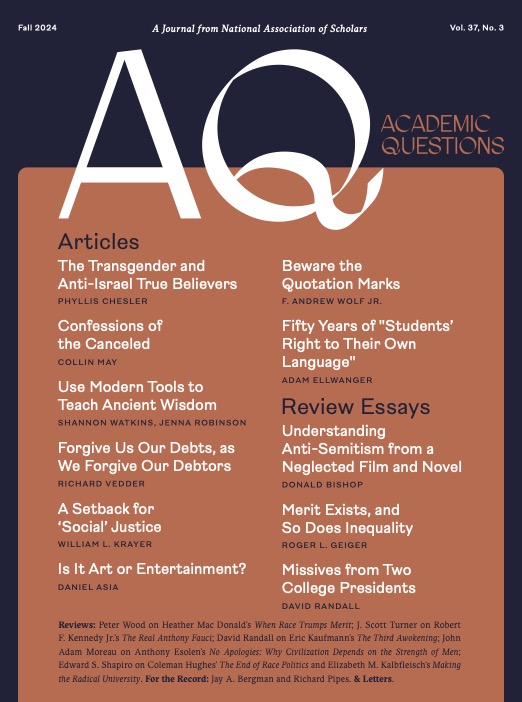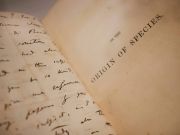The Mortal Storm, Metro-Golden-Mayer, directed by Frank Borzage, 1940, 1 hour 40 minutes, B&W, available on DVD from leading outlets.
The Mortal Storm, Phyllis Bottome, Little, Brown and Company, 1938, pp. 357, available from used booksellers.
With the war between Hamas and Israel has come a surprising new outbreak of anti-Semitism in the United States and in Europe. Now is a time to watch, listen, and learn from some stars of Hollywood’s golden age—Jimmy Stewart, Margaret Sullavan, and Robert Young among them.
Beyond criticism of Israel’s tactics and goals, the war has loosened older anti-Jewish prejudices and tropes. Defacing synagogues, shouting down campus speakers, hate speech, harassment, individuals having to hide a Star of David or kippah, malicious postings on social media, notions of Jewish financial and political power, labeling Jews as oppressors, and Holocaust denial have been among the signs. To fully understand this ugly moment, a conference would require gathering experts in history, psychology, sociology, area studies, disinformation, social media, religious teachings, and many other disciplines.
Not many Americans attend academic conferences, however. But they watch films.
Over the decades Hollywood helped audiences understand various forms of anti-Semitism and the Holocaust in such movies as Gentleman’s Agreement (1947), Schindler’s List (1994), Chariots of Fire (1982), I Accuse! (1959), Judgment at Nuremberg (1961), and Conspiracy (1997), and each of these still offers understandings of prejudice and hate. Wikipedia, IMDB, and the CJP Antisemitism Initiative provide suggestive lists. There’s a film that has somehow not been included on the usual lists, however. It should be.
The Mortal Storm premiered in American theatres in 1940. Directed by Frank Borzage, its leading roles were played by Margaret Sullavan, Jimmy Stewart, and Frank Morgan. Many other stars—Robert Young, Robert Stack, and Ward Bond—filled out the cast. Robert Osborne noted it was “one of Hollywood’s first warnings to moviegoers about the Nazi menace.” The review in the New York Times on June 20, 1940, was bolder: “on the basis of recorded facts and the knowledge that its drama is authentic, this picture turns out to be one of the most harrowing and inflammatory fictions ever placed upon the screen.”
Set in a German university town near Austria, the story opens on January 30, 1933. Viktor Roth (Morgan), a professor of physiology at the medical school, has turned 60. That morning he is greeted warmly by his family and medical school colleagues with a birthday tribute and the old academic song, “Gaudeamus Igitur.” We meet a student of medicine, Fritz Marburg (Young) and a classmate studying veterinary medicine, Martin Breitner (Stewart). Both—one openly, one secretly—hope to win the hand of Professor Roth’s daughter, Freya (Sullavan).
In the professor’s family—his wife, two stepsons, the daughter, and another son—he is the loved paterfamilias. That evening at an affectionate family dinner, however, the radio reports that Adolf Hitler has been named Chancellor of Germany. The stepsons, son, and his daughter’s suitor Fritz cheer the news. “We’ll see a new Germany”; “It means our country will be strong and powerful again, master of Europe and the world”; “A strong man in the saddle, a leader who will fight for victory”; “If nations want peace, they have nothing to fear”; “If they want war, by heaven they’ll get it.”
While Professor Roth tactfully states, “Men have given great power to Adolf Hitler. Let’s hope responsibility brings wisdom,” he and his wife are anxious because he is “non-Aryan.” And Martin and Freya don’t join the others’ jubilation.
Before the dinner ends, the stepsons and Fritz leave for a Party meeting. In subsequent weeks, members of the university faculty distance themselves from their Jewish colleague.
Giving a lesson on hematology, Roth is challenged by a brownshirted student. “Is it your opinion that there is no difference between the blood of an Aryan and the blood of a non-Aryan?”
Professor Roth replies, “Those are the findings of science. Until now, physiology has been unable to discover any difference in the blood of the various races.”
The student declares that Professor Roth has directly contradicted the teachings of Germany’s new leader on racial purity, and he leads the other medical students as they walk out of the classroom. Joining them is Fritz, Freya’s suitor.
Roth’s interactions with other members of the faculty become strained as they distance themselves from their “non-Aryan” colleague. The historian Niall Ferguson has been exploring how, in the 1930s, German universities “antisemitism became institutionalized.”1
This film gives some glimpses.
Scenes in the film also show Nazi thugs pummeling a Jewish neighbor, book burning, ski patrols along the Austrian border to prevent dissenters from escaping, resignation of the Roths’ household staff, the sundering of ties between the siblings, Professor Roth’s arrest and departure for a concentration camp, seizure of a medical manuscript, and the attempt by Freya and Martin to escape to Austria on skis. The German border patrol kills one of them.
Borzage and the film’s primary scriptwriter, Jessica West, were clear on the Nazi menace, and the film shows how anti-Semitism was presented then, in 1940. More than eighty years later, this old film can help us see parallels — intolerance for the sake of a cause, submission of an individual’s conscience to a leader’s or a party’s demands, division among family members, the desertion of friends, groupthink, ugly consequences for wrongthink, censorship, and self-censorship, to name a few. Fritz, who led the ski patrol to prevent the escape of Martin and the woman he hoped to marry, Freya, exclaims, “I had no choice. It was my duty.”
The film was based on a novel by Phyllis Bottome, published in the United Kingdom in 1937 and in the United States in 1938. (The American edition added three more chapters to strengthen its anti-Nazi themes.) A book tour in the United States extended the reach of the novel, and she lived in Hollywood after MGM purchased the rights, wanting to ensure that the novel’s messages not be watered down. Hollywood was, however, experienced dealing with writers who possessively wished to influence film versions of their work, so her influence was limited.
There are differences between the novel and the film. Movie versions of novels must always be compressed; perhaps half of Bottome’s The Mortal Storm was omitted. So were its insights on class prejudice, and the film did not pick up on Freya’s feminist thinking.
In the book, the film’s “Martin” had been “Hans,” not a medical student but a peasant and a (naively idealistic) Communist. It was the Reichstag fire, not Hitler becoming chancellor, that inaugurated the novel’s crises. And MGM pulled some punches. Apparently hoping to preserve access to the German box office, there’s no use of the word “Jewish” in the dialog; the euphemism was “non-Aryan.” Although the characters in brownshirts wear swastikas, there’s no explicit mention of “Nazis.” In the closing scenes on the mountain, a different character falls to the bullets of the ski patrol.
Some scenes were added in the screenplay. The birthday dinner scene is in the film, not the book. So was the seizure of Professor Roth’s unpublished manuscript by German border authorities. These scenes added by West and the studio, however, brought together insights scattered through the longer novel.
Most surprisingly, the key scene in the classroom with its discussion of races and blood is nowhere in the novel. Adding it to the screenplay allowed Jessica West to criticize Germany’s racial laws and what Winston Churchill would later call “perverted science.” The film was released on June 14, 1940, and premiered in New York on June 20. Churchill gave his “This was their finest hour” speech to the House of Commons on June 18. Perhaps some early viewers of “The Mortal Storm” better understood one of the perversions of Nazi science.
Did the scene help some Americans understand that the segregation of blood by race in America’s blood banks was medically unjustified? And today, might the scene filmed eight decades ago help Americans think through recent discussions of “poisoning the blood of our country”?
If MGM somehow hoped that tickets bought by German filmgoers could continue to boost its bottom line, its efforts to mute the screenplay failed. Joseph Goebbels was not fooled. He banned not only the film but all MGM movies from showing in the Reich and the territories it controlled.
Now understanding how the anti-Semitism of Nazi policies in the 1930s became the Holocaust of the war years, we can judge that the 1941 hearings led by isolationist Senators that asked whether The Mortal Storm was “propaganda” were misguided.
Scholars who have examined the film and/or the novel at length include Alexis Pagorelskin and Pam Hirsch. Brandeis professor Thomas Doherty and actor James Beaman have written fine appreciations. And fans will enjoy Jimmy Stewart’s lighthearted, self-effacing recollection of making the film on a television program with Dean Martin.2
The Mortal Storm is not widely available for free streaming, though one website claims it is available on HBO’s Max. The film has run from time to time on Turner Classic Movies, which likely holds the rights thereto. So here is a message to TCM and the various streaming services: in this moment of ugly anti-Semitism, make this film available to stream—for free. Now, not later.
Donald Bishop is a retired Foreign Service Officer, now a Krulak Center Distinguished Fellow at Marine Corps University. The opinions in this essay are his own.
1 Niall Ferguson, “The Treason Of The Intellectuals,” Uncommon Knowledge interview, Hoover Institution, January 23, 2024.
2 Alexis Pagorelskin, “Phyllis Bottome’s The Mortal Storm: Film and Controversy,” online at https://www.monmouth.edu/department-of-english/documents/phyllis-bottomes-the-mortal-storm-film-and-controversy.pdf/; Pam Hirsch, “Authorship and Propaganda: Phyllis Bottome and the Making of The Mortal Storm (1940),” online at https://www.tandfonline.com/doi/abs/10.1080/01439685.2012.648053; Thomas Doherty, “When Hollywood Fought Nazis,” Tablet, 14 May 2009; James Beaman, “The Mortal Storm,” online at https://jamesbeaman.substack.com/p/the-mortal-storm; “Dean Martin & Jimmy Sewart – Featuring ‘Ragtime Cowboy Joe,’” online via youtube at https://www.youtube.com/watch?v=NxP8-kbcYBM
Photo by fergregory on Adobe Stock














